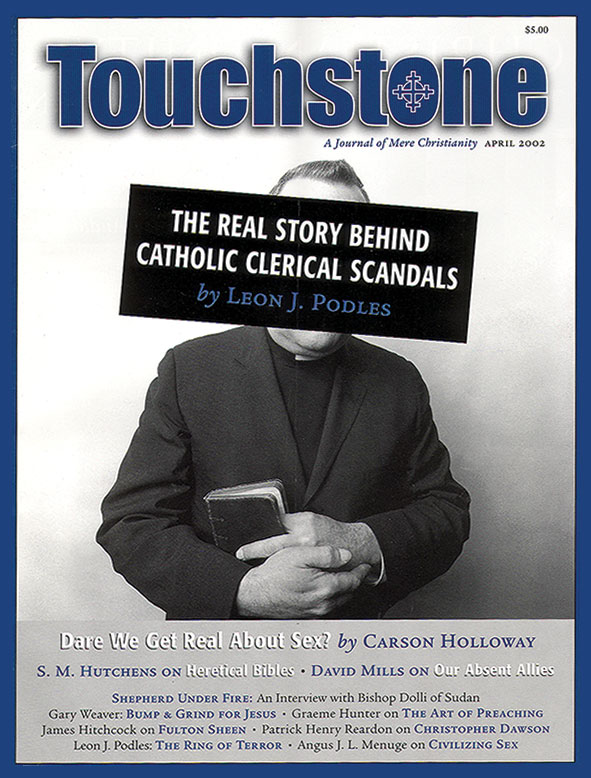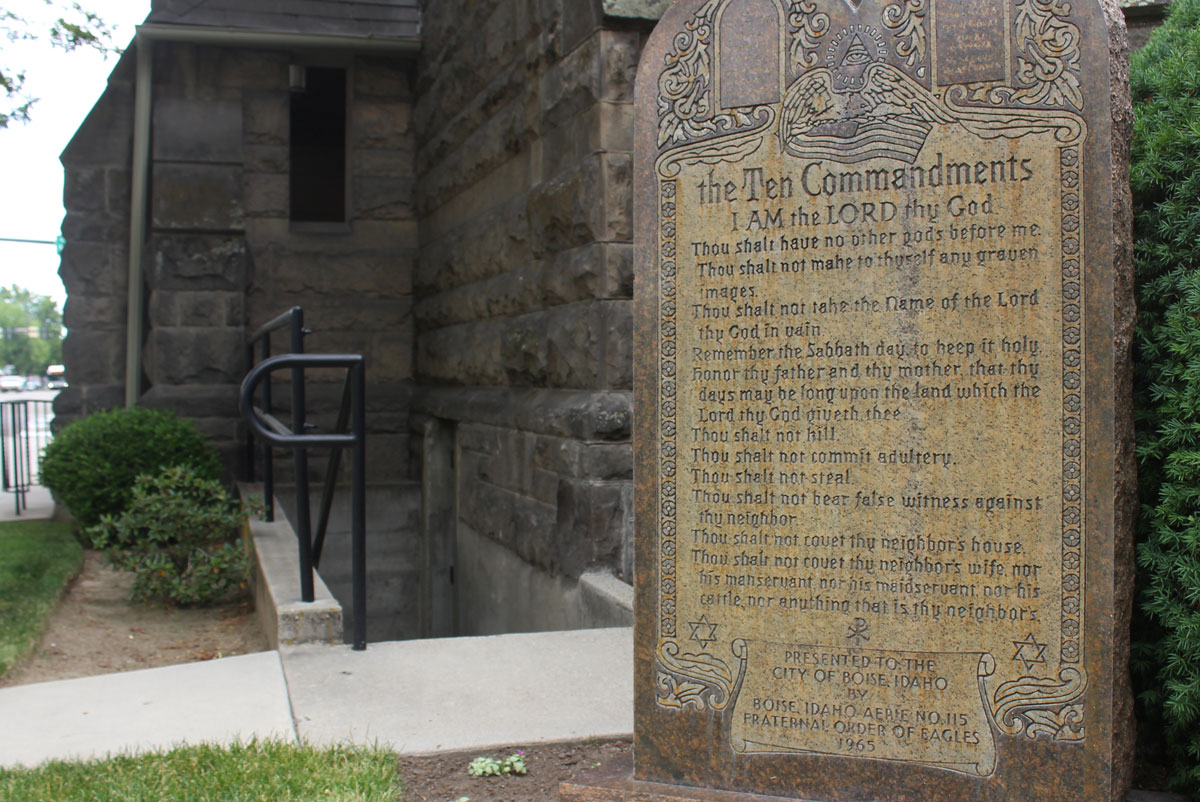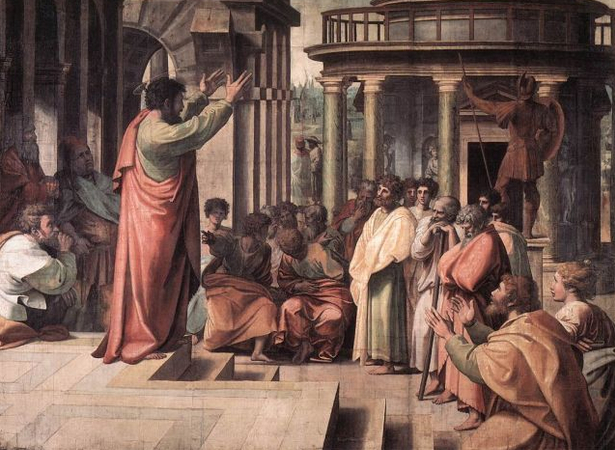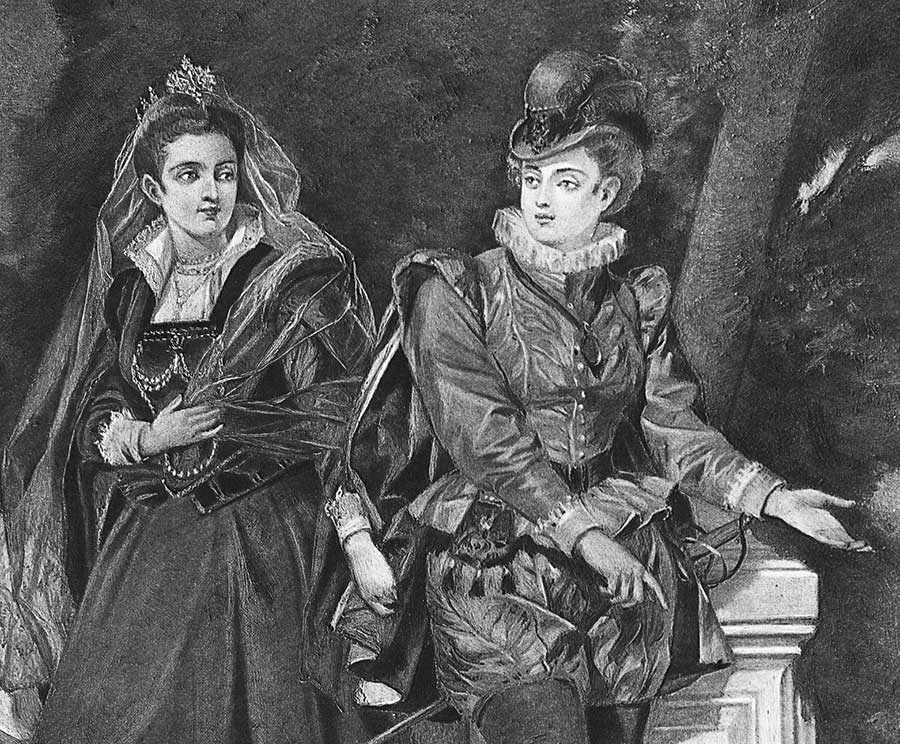Bump & Grind for Jesus
Gary R. Weaver on Redeeming the Culture
So here I am, amidst a “standing room only” crowd in a large, darkened hall, the only light issuing from spotlights trained on the empty stage. The act is announced, and a dozen or more twentyish women in snug-fitting denim and knit fabric take the stage. They have only a few seconds to form a line before the loud rock soundtrack envelopes the room with its pounding drums, pulsating bass, and largely inscrutable vocals.
On musical cue, the performers begin strutting about the stage, jumping, twisting, bending, and waving, mostly in coordinated fashion. Soon they turn their backs to the audience, bend slightly so as to force their backsides to protrude toward us, and proceed to swivel and shimmy their buttocks quite sensually, in the fashion of Elvis (for you oldsters) or hip-hop “booty” dancing (for you youngsters). Then it’s on to similar hip swiveling seen from the front, along with slowly gyrating legs, heads thrown back, arms outstretched, and so on.
The audience sometimes expresses its appreciation—typically with applause, occasionally with a catcall or a hoot. You get the picture, so I needn’t go on, but there is one more important detail: The soundtrack’s inscrutability occasionally breaks for a reasonably clear shout of “Praise God,” whereupon the dancers all point a finger to the ceiling and put a smile on their faces.
You see, I’m not at a Las Vegas show, MTV taping, or worse, but attending chapel at a respected Christian college, and the standing-room-only crowd constitutes most of the student body. Bump and grind for Jesus!
A First Reaction
My first reaction in situations like this is to think frantically: “Where are the grownups?” But the grownups—specifically, a college staff person who looked to be in his forties—not only introduced the student dance group but enthusiastically pressed the crowd for a “rousing hand of applause” upon the conclusion of the group’s routine. The crowd (large, but largely and, I was told, typically devoid of faculty) responded as requested, especially the male students, I thought—the women were somewhat more subdued in their appreciation.
The ceremonies then moved on to the Bible passage for the day, which itself was followed by applause. (Is Bible reading now perceived as entertainment?) Then came the message based on the reading. It was offered by someone from outside the United States—I’d have loved to know his reaction to the “opening act,” an act that probably didn’t prepare the crowd to receive his rather sober message.
I found the whole setting more than incongruous. My son, who is in his late teens and was traveling with me on this occasion, had a simpler description: “It was gross.”
Now, I’ll be the first to admit that when it comes to what usually is called liturgical dance, I as often as not “don’t get it.” On those rare occasions when a bit of liturgical dance occurs in my Lutheran church, perhaps in the context of a special service or program, I try hard to grasp it, though my effort sometimes fails. But I’m willing to grant that it might be my fault and that I shouldn’t criticize or complain without first learning the kinetic language of the dance (which is to say something akin to what I say to people who complain that they are befuddled by the Catholic Liturgy).
But there’s a bit of a difference, I think, between liturgical dance done by my rather conventional Lutherans (e.g., Mary, in flowing robes, dancing out the joy spoken in the Magnificat) and this Christian college chapel. In the latter, the kinetic language seems pretty clear, and it’s mostly the language of MTV, Las Vegas, or maybe even an “exotic dancer” bar in a seedy part of town.
Moreover, the problem was not just an isolated event at this college, on this one day. I witnessed a permanent, organized group at this particular school. I queried a friend who teaches at another well-known Christian college and was advised that his institution also has such a group. Thankfully, he noted, they’re not allowed in chapel—yet—but they do regular performances on campus for audiences that are almost entirely male. If they really were using a language of liturgical dance, and used it well enough to attract others to rejoice in their dance of praise, wouldn’t women attend also?
So do we need a historian or social critic to write about “the opening of the Evangelical libido” just as Mark Noll has described the closing of Evangelical minds? Admittedly, my middle-aged and generally “old fogey” attitudes surely frame my interpretation of events like this. But some like-minded old fogey at the college perhaps should tell these women that their intended dance of praise might send a very mixed message.
But just what are the intentions? What is going on here? Or, put more humbly, what am I, in my benighted or corrupted state, missing or misinterpreting in the chapel program at this college that, in most other respects, I hold in high esteem? (Indeed, it’s because I generally hold this college in high esteem that I’d rather not identify it, lest its many good works be tainted or undermined by the particular event under review. In fact, I’d be happy to send my children there, albeit suitably warned about certain chapels and the theology undergirding them.)
Explaining Chapel
It won’t do to explain bump-and-grind chapel in purely pragmatic, utilitarian terms (i.e., gyrating women increase male attendance at chapel). After all, chapel is required at this school: no chapel, no diploma. Moreover, what about the males, who, like my son (“It was gross”), are a little concerned about doing things decently and in good order? And what do the other women think of this display?
One would hope that even the most fervent proponents of entertainment evangelism would be unlikely to pander so boldly as this, either to others or to themselves. No, if a college wants a less embarrassing way to keep males happy in chapel, there probably are enough pious athletic stars and coaches available.
So perhaps I am missing a radical liberationist issue, i.e., that women (or anyone else, for that matter) should be free to use their sexuality to glorify God, and that any “problem” I have with that reflects my enculturation into and perpetuation of the norms of an oppressive and repressive patriarchal culture. In short, “get over it, old fogey.”
If this were, mirabile dictu, required chapel at what we in the business refer to as “an elite East Coast private university,” I would not be too surprised, and we could proceed to discuss the merits and demerits of this outlook. But it is not an elite East Coast private university; it is an institution full of mostly middle-American, middle-class, “family values” people who, one suspects, would take very seriously Levitical requirements that one not place a stumbling block before one’s brother. Sociologically, this explanation just doesn’t fit.
Now this school, like many other Christian colleges, does have a multicultural component in its curriculum, showing sensitivity to and awareness of the Church and its work in different cultures around the world. So could a “bump and grind” chapel simply reflect sensitivity to the culture of many (or even just a few) students? Again, this seems too much of a stretch. The culture reflected by bump-and-grind is a popular culture manufactured by a media/entertainment complex, rather than an indigenous folk culture. Since when did multicultural sensitivity, even sensitivity to various American subcultures, mean taking manufactured mass culture as given?
So let us try some theology. Perhaps they are trying to engage, transform, and redeem the culture. Perhaps I witnessed the work of “Christ the transformer of MTV culture,” as H. Richard Niebuhr might have put it had he been able to join me this morning.
But merely sticking “praise God” in the midst of an activity doesn’t seem quite what Niebuhr had in mind, nor can I envision Calvin or Luther viewing the idea of Christian vocation in such simplistic fashion. Bonhoeffer worried about cheap grace; this looks like cheap culture transformation.
Now, I have often had people tell me that (for example) Luther used “drinking songs” as hymn tunes, so why not apply Christian content to other worldly entertainments? But this is just dubious history in the service of popular culture. Luther’s appropriation of secular tunes constituted a miniscule portion of his overall musical effort, and—like a few other decisions of his—reflected an expedient accommodation to circumstances.
In Reformation Germany, there just weren’t many usable new tunes for corporate worship in the vernacular. So tavern songs might be used in a pinch, but with the aim of moving on to music composed by and for the church, and with a careful eye as to whether the conventional implications of the form of the music might conflict with the sacred intent of the hymnody.
Thus, some tavern tunes might pass muster as an expedient, but not every tavern tune is admissible. Would Luther have set the words of “A Mighty Fortress” to the tune of “The Priest of Kalenburg” or “Dietrich of Berne,” two popular songs against which he railed in a sermon on Ephesians 5? Not likely.
Pious Intentions Not Enough
More generally: Form is not without content; the medium is at least part of the message, to borrow from Marshall McLuhan. And so this Christian college chapel left me with a sense of having witnessed a profound contradiction between form (MTV/Las Vegas/exotic dancer) and intended content (“Praise God!”).
But aren’t good intentions enough? Is it not sufficient that this group of students, and their sponsors, sincerely intended their actions to bring praise and honor to God, just as much as, say, J. S. Bach intended his music to glorify God?
I am quite willing to grant the good intentions, but to insist that good intentions are enough seems too close to one or another ancient and modern heresy. Saying that it is my own private thoughts and intentions that determine the character of my Christian life at least flirts with Gnostic thinking and other “special,” non-catholic revelations. It also risks a Manichean rejection of the corporeal world as a proper realm of divine, salvific activity, and perhaps even a dichotomizing of the blatantly corporeal narrative of the Old Testament from a supposedly more “spiritual” and thus private New Testament gospel of salvation.
Yet this inward and personal understanding of Christianity is characteristic of much contemporary Protestantism, both Evangelical and mainline. Methodist theologian Stanley Hauerwas has observed that post-Enlightenment Protestantism is unusual in Christian history for assuming that being a Christian reduces to questions of one’s state of mind, whether those questions be matters of confessional doctrine or Evangelical decisions to “accept Jesus Christ as my personal savior.”
Lutheran theologian David Yeago (writing in the Christmas 2000 issue of Lutheran Forum) more generally refers to this tendency as “the disembodiment of Christianity,” and observes how starkly it contrasts with the “dense corporeality of earlier forms of Christianity.” In that earlier, more corporeal Christianity, creation is not sanctified by good intentions and pious thoughts (“cheerleading for Jesus,” an acquaintance of mine calls it), but by “the public presence of a bodily people, [drawing] created things into new patterns of usage within a distinctive corporate way of life.”
In short, perhaps the dancers were proclaiming that their godly intentions are sufficient to redeem all things. But that is, in the end, an American, or more generally, modern Western message quite at odds with the Church’s message over the ages. By recognizing it, however, we can better understand how well-intentioned persons can be found bumping and grinding for Jesus. Denying the corporeality of the faith makes it that much easier to adopt the debased corporeality of the fallen.
Gary R. Weaver is a faculty member at the University of Delaware (though he also has served as operator of the world’s longest railroad drawbridge). He holds Ph.D. degrees in philosophy and business administration. He and his wife June have two children, Evan and Priscilla.
subscription options
Order
Print/Online Subscription

Get six issues (one year) of Touchstone PLUS full online access including pdf downloads for only $39.95. That's only $3.34 per month!
Order
Online Only
Subscription

Get a one-year full-access subscription to the Touchstone online archives for only $19.95. That's only $1.66 per month!
bulk subscriptions
Order Touchstone subscriptions in bulk and save $10 per sub! Each subscription includes 6 issues of Touchstone plus full online access to touchstonemag.com—including archives, videos, and pdf downloads of recent issues for only $29.95 each! Great for churches or study groups.
Transactions will be processed on a secure server.
more on culture from the online archives
more from the online archives
calling all readers
Please Donate
"There are magazines worth reading but few worth saving . . . Touchstone is just such a magazine."
—Alice von Hildebrand
"Here we do not concede one square millimeter of territory to falsehood, folly, contemporary sentimentality, or fashion. We speak the truth, and let God be our judge. . . . Touchstone is the one committedly Christian conservative journal."
—Anthony Esolen, Touchstone senior editor












